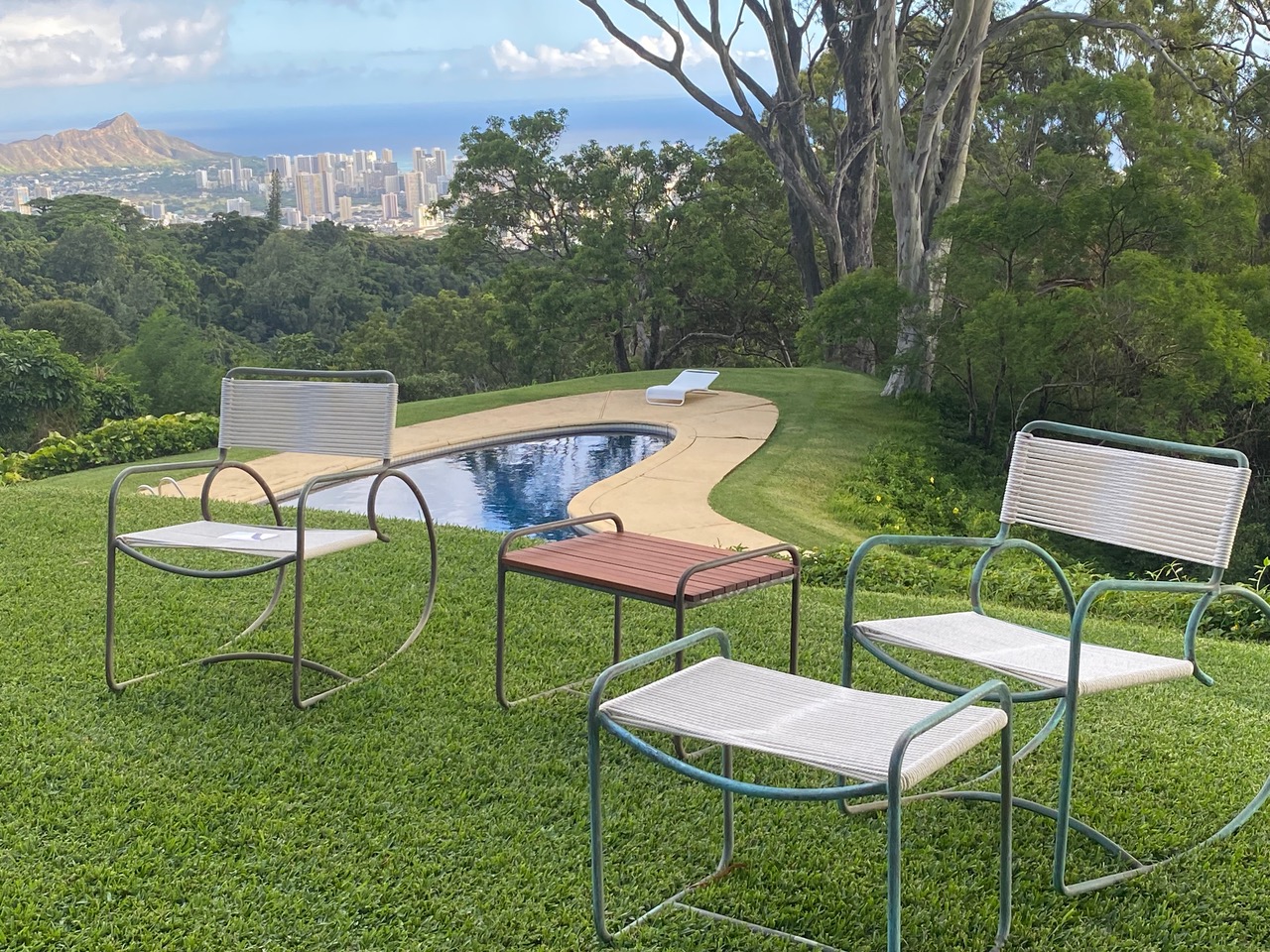Make a gift today, and your donation will be DOUBLED, thanks to a generous group of Civil Beat donors!
Help us raise $250,000 by December 31.
Denby Fawcett: These Chairs Started Out As Pearl Harbor Scrap Metal. Some Now Sell For $35,000
Designer Walter Lamb started making his distinctive chairs after spotting a huge pile of bronze tubing that had been salvaged from ships sunk during the 1941 attack.
September 17, 2024 · 8 min read

About the Author
Denby Fawcett is a longtime Hawaii television and newspaper journalist, who grew up in Honolulu. Her book, Secrets of Diamond Head: A History and Trail Guide is available on Amazon. Opinions are the author’s own and do not necessarily reflect Civil Beat’s views.
Designer Walter Lamb started making his distinctive chairs after spotting a huge pile of bronze tubing that had been salvaged from ships sunk during the 1941 attack.
When I was growing up in Honolulu, Walter Lamb chairs were so ubiquitous that nobody paid much attention to them.
They seemed to be on every lanai, by the sides of swimming pools and perched on garden patios under shady trees.
That was in the pre-air conditioning days of 1950s Hawaii when people loved to entertain outside in the cooling trade winds.
The handmade chairs also dotted patios of locations like the Halekulani, the Coral Strand, the Hana-Maui Resort and the Pacific Club.
What I didnʻt know back then is how the architect-designer found the bronze to make the chairs during World War II when many materials in Hawaii were in short supply.
The origin story sustains the mystique of his furniture.
Walter Lamb’s furniture was welded into artistic shapes from bronze tubes that the Navy had salvaged from ships damaged or sunk during the Dec. 7, 1941, Japanese attack on Pearl Harbor. The seating in Lambʻs original pieces was made of ordinary cotton clothesline rope.
Josh Feldman, president and CEO of Tori Richard, like a lot of other Hawaii kids I knew in my time, disliked Walter Lamb furniture, finding it uncomfortable; the rope seats dug into his skin and pinched him. But he said he changed his mind after his father told him the chair frames came from sunken battleships.
“The pieces had such a romantic backstory. I got the bug and started collecting them after I graduated from college. I bought the first chair on eBay for $150. I wish I had bought more at the time. Now the prices have become prohibitive,” he said.

In a phone conversation, Walter Lamb’s daughter, Sandra Lamb Peterson, remembered accompanying her father to Pearl Harbor after the Navy hired him as a civilian to design a new officers’ club after the attack.
On their visit, she said, they saw a huge pile of bronze tubing.
“My father asked the officers what they planned to do with it. When they said they didn’t know, he said ‘I’ll take it off your hands,'” she recalled.
The bronze tubing — impervious to rust — was used on Navy ships to protect electrical wiring.
Lamb hauled all the salvaged metal to his Hawaii Interiors store and mill at 1171 Kapiolani Blvd. where he and his workers began experimenting with shaping the tubing into distinctive chairs and tables, which today are sought out at auctions and estate sales as far away as Camden, Maine, and Palm Beach, Florida.
Prices have soared up to $35,000 for certain rare and distinctive Lamb pieces such as his three-seater sofa listed for sale at the Los Angeles showroom DEN.
“I couldn’t believe it,” Sandra Lamb Peterson said when she saw online a single dining armchair selling for $6,000.
‘Known Yet Unknown’
Wendy McClain, owner of McClain Auctions Hawaii, said any Walter Lamb table with chairs will be in high demand and sell for a winning bid of at least $12,000.
Lamb’s pieces also have been honored in museum retrospectives — most recently in August at an exhibition at Liljestrand House — a home-turned-museum on Tantalus Drive designed by architect Vladimir Ossipoff.
Despite Lamb’s renown, scant written information can be found about his thoughts on finding the fateful scrap pile at Pearl Harbor in the 1940s, how his designs evolved or how he adapted to becoming famous.

“He is one of the most collected designers in the U.S. coming out of Hawaii, yet it is difficult to find much about his work compared to the proliferation of information about furniture designers such as Charles Eames. Lamb is known yet unknown,” said John Reyno, the premier collector and restorer of Walter Lamb furniture in Hawaii.
Reyno and writer Jane Marshall Goodsill were the keynote speakers at the Liljestrand House Lamb retrospective. Reyno grew up in California’s San Fernando Valley and after college opened up a welding business in Costa Mesa, California, with his twin brother, Jeffrey Reyno.
John Reyno said they sold their welding company, then he moved to Oahu in 2007 intending to retire and board and kite surf. But as a lover of metals, he soon became enamored of the Lamb pieces and began collecting and restoring chairs and tables for himself.

Now, he is refreshing and selling Lamb’s work and other modern furniture as a full-time profession with a repair shop in Kakaako. Later this year, his company Hawaii Modern will open a furniture showroom in Kailua.
Reyno said the lack of information about Lamb might be because the designer did not need to promote himself. He and his wife Rubye-Lee, known as “Billie,” arrived in Honolulu in 1935. They were legendary hosts at the Lamb-designed home on Kalanianaole Highway called “Waipuna” — sometimes entertaining as many as 500 people on tours to benefit island charities.
The residence was visited by hundreds of people year after year including celebrities like Bob Hope, Esther Williams, Shirley Temple, Arthur Godfrey and Walt Disney.
All were eager to see its sweeping garden surrounding an ancient Hawaiian fishpond with a small, palm tree-filled center island. The Lambs used a nearby freshwater spring called Kanewai, which was filled by water from a lava tube, to irrigate the garden and for swimming.
Famous Visitors
The legendary hula dancer Iolani Luahine was filmed dancing at Kanewai in a 1947 documentary, and John Wayne was filmed in a scene by the fishpond for the movie “Big Jim McLain.”
Sandra Lamb Peterson said visitors were intrigued by the Lamb furniture that they saw in the garden and asked to buy pieces to be sent to their homes here and on the mainland. “He did his business by word of mouth,” she said.
The family sold the home in 1952 and moved to Pebble Beach, California. Soon after that Lamb entered into a partnership with Brown Jordan outdoor furniture company in Pasadena. Lamb did the designing and Brown Jordan the manufacturing.

Brown Jordanʻs Walter Lamb pieces are made of thinner tubes of brass metal dipped in acid to give them a greenish hue. Of course, the tubing is no longer from sunken ships. Sandra Lamb Peterson said her father ran out of Pearl Harbor salvage metal when the Lambs were still in Honolulu and had to buy it from other sources.
Brown Jordan chief brand curator Steven Elton says although Lambʻs early Honolulu designs were bronze he also began to use brass when he started to buy his materials from the mainland.
The Brown Jordan Walter Lamb pieces are not as attractive or subtly hued as Lambʻs Hawaii originals, but they sell for comparable prices.
Walter Lamb died in Montecito, California, in 1980 at age 79.
Collector’s Items
Brown Jordan continues to sell Walter Lamb designs, but the most recent models have taken a flashy turn. Released in 2019, they are called “reissued Walter Lamb” chairs. The company advertises them as coming in 23 different powder-coated aluminum frame colors including blush pink, which Reyno says might work in some of the drier climates on the mainland but wouldn’t last long in humid Hawaii.
The Lamb home at 5975 Kalanianaole Highway has been bought and sold many times. The current owner is the Maunalua Fishpond Heritage Center, a nonprofit community organization that says it intends to preserve the freshwater spring and ancient fishpond.
The foundation, in partnership with the Trust for Public Land, raised $2.3 million to purchase the Lamb property from a Japanese corporation in 2017.
Executive director Chris Cramer says the foundationʻs key mission is to work with community and school groups to preserve the pond and spring, but it also cares about the Lamb home. It is launching a campaign to raise money replace the Lambsʻ original crumbling shake-tile roof.
Walter Lambʻs chairs are long gone from lawns surrounding the fishpond and the spring. All of his creations are now in the hands of collectors eager to find more.
 Sign up for our FREE morning newsletter and face each day more informed.
Sign up for our FREE morning newsletter and face each day more informed.
Read this next:
Naka Nathaniel: Hawaii's Ag System Needs An Overhaul To Promote Food Independence
By Naka Nathaniel · September 18, 2024 · 6 min read
Local reporting when you need it most
Support timely, accurate, independent journalism.
Honolulu Civil Beat is a nonprofit organization, and your donation helps us produce local reporting that serves all of Hawaii.
ContributeAbout the Author
Denby Fawcett is a longtime Hawaii television and newspaper journalist, who grew up in Honolulu. Her book, Secrets of Diamond Head: A History and Trail Guide is available on Amazon. Opinions are the author’s own and do not necessarily reflect Civil Beat’s views.
Latest Comments (0)
Mahalo Denby.Always a pleasure to read something good about Hawaii.Now I know.
808Allday · 3 months ago
Yikes! I have 8 of those sitting under the house that Iâve been meaning to re-string for years. Better get busy . . .
Harvey · 3 months ago
You can always find collectors for something. These pieces of furniture are pretty great examples of "upcycling" and subtly paying homage to great capital ships from an era that are mostly long gone now.
WhatMeWorry · 3 months ago
About IDEAS
IDEAS is the place you'll find essays, analysis and opinion on public affairs in Hawaii. We want to showcase smart ideas about the future of Hawaii, from the state's sharpest thinkers, to stretch our collective thinking about a problem or an issue. Email news@civilbeat.org to submit an idea.

